Most SEO reports still lead with rankings, clicks, or traffic lifts. But when I talk to senior stakeholders, they don’t care about that.
They want to know how our work contributes to revenue. Not “we increased traffic by 25%,” but “we generated enough profit to buy a fifth tractor.”
In this article, I’ll share a framework to measure the ROI of organic content. You can also use it to prioritize work, justify investment, and forecast growth.
The problem with our outdated measures of success
Clicks don’t equal business value
Too many SEO reports lean on metrics that sound impressive internally but fall flat in boardrooms. Senior stakeholders care about what drives the bottom line: revenue, margin, and profit.
The real impact isn’t “25% more traffic” but whether it grows the business in tangible ways. If your metrics don’t reflect financial outcomes, they’re not telling the whole story.
Conversions aren’t always cash in the bank
Not all conversions are created equal. A one-off £100 purchase might look great on paper. However, an £85 purchase plus a subscription to free delivery is far more valuable in the long run.
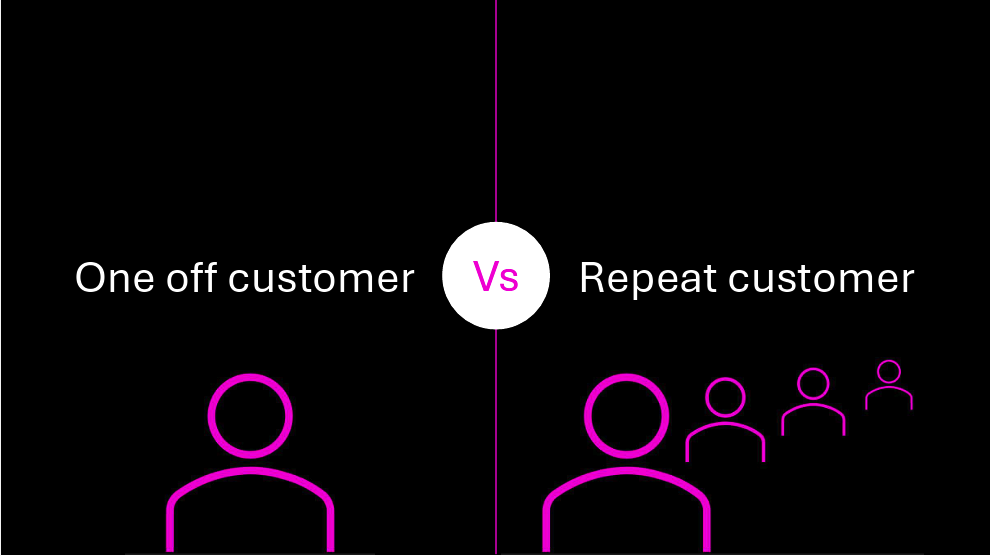
Standard conversion reporting doesn’t account for refunds, customer churn, or lifetime value, which means you might overestimate a page's actual performance.
Traffic growth can still cost you money
High-traffic pages aren’t always assets, especially if they’re not converting.
Even if a page isn’t generating revenue, it still incurs costs like server bandwidth, hosting, and content maintenance, which scale with traffic. Without knowing your pages' ROI, you risk scaling content that actively loses money and leads to content waste.
Get actionable insights to fix declining traffic and improve visibility
only at MozCon New York

How to calculate the ROI of organic content
1. Understand ROI
You can’t prove success without defining what it means. For content ROI, it comes down to a simple equation:
Return is the revenue generated through organic website visitors. However, revenue isn’t always directly attributed to a single page or channel.
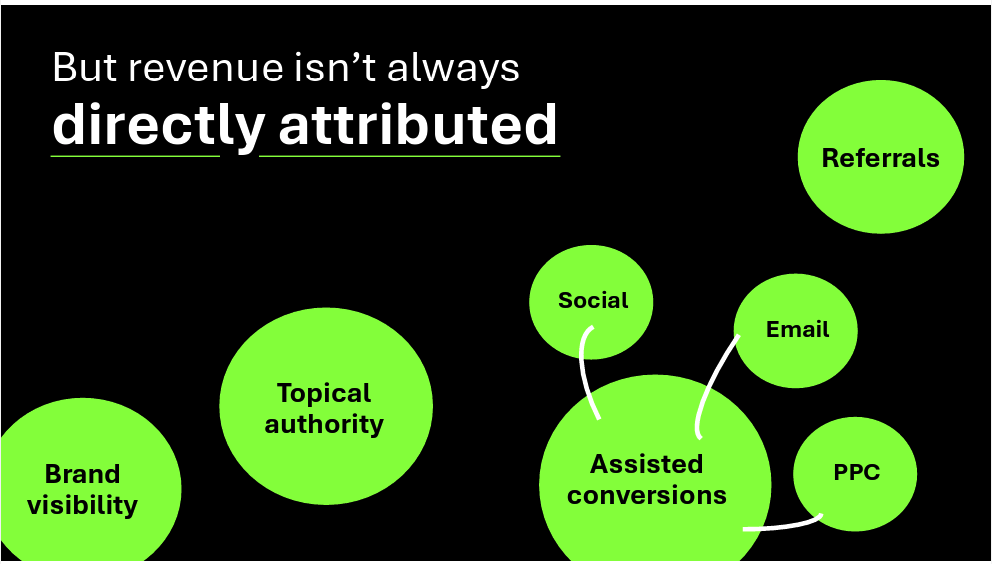
Organic content often supports other parts of the funnel, such as:
- Boosting brand visibility
- Building topical authority
- Assisting conversions across email, social, PPC, and referrals
Good reporting accounts for that broader influence, especially for content that drives discovery or re-engagement.
Investment is the hosting and tech cost to serve pageviews. It includes infrastructure, like CDN usage, server bandwidth, firewalls, monitoring tools, and database operations.
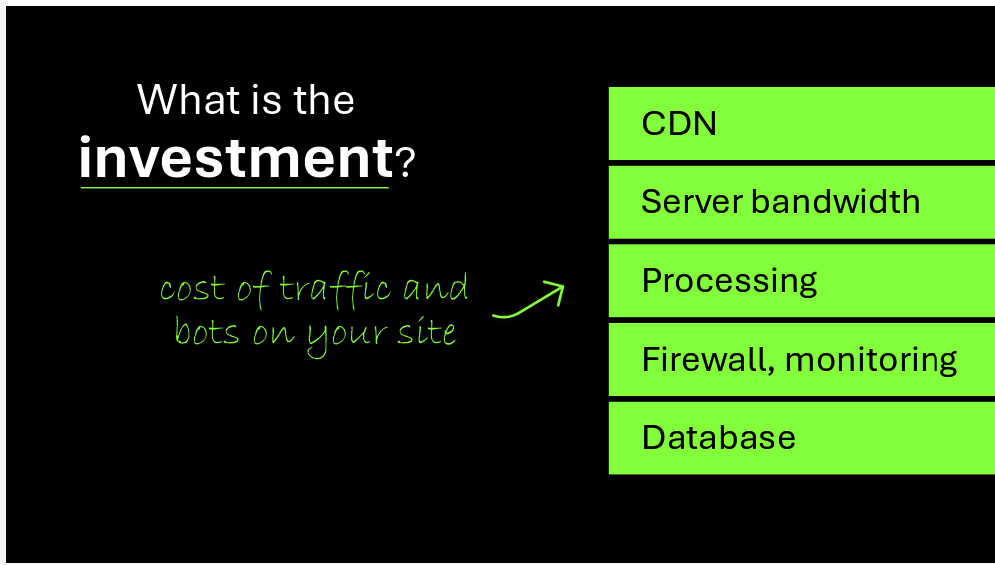
Instead of viewing content as a fixed cost, treat every page as a unit of investment. That mindset shift lets you identify value and cut what doesn’t pay off.
2. Calculate the value of a page
Determine cost per pageview
Start with your hosting and infrastructure costs. Divide your monthly total by the number of annual pageviews. Then, speak with your developers to understand how much it costs per page view from a visitor or per hit from a bot, and calculate how it scales as you get more traffic or bot hits.
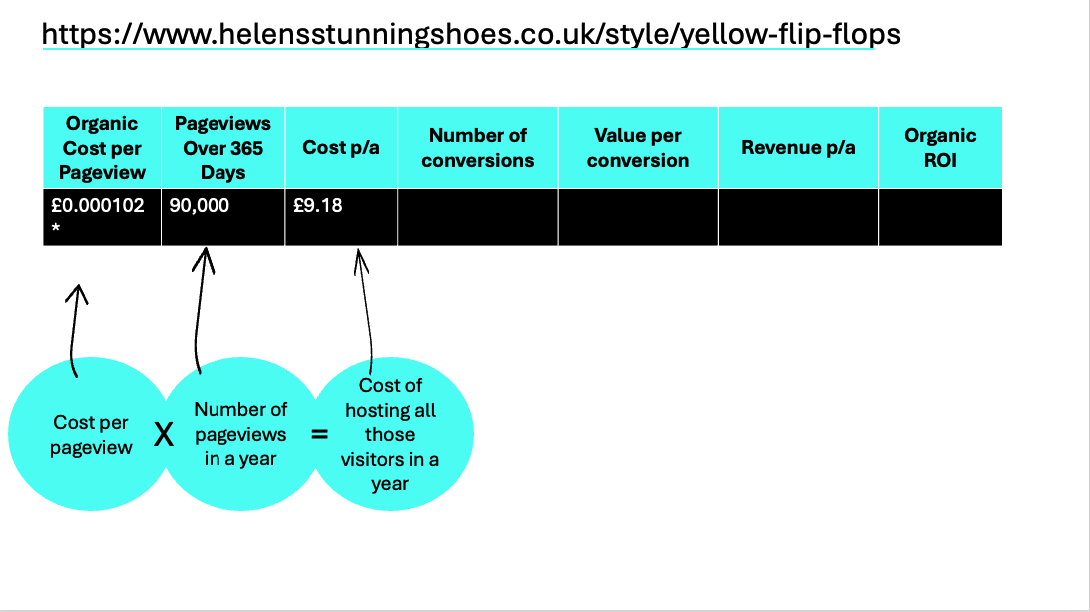
For example, I created a fictitious site called Helen’s Stunning Shoes and attributed some metrics to help you understand the calculations.
Calculate annual organic pageviews
Use Google Search Console or your preferred analytics tool to get 12 months of data per URL.
For example, the yellow flip-flop page received 90,000 page views in the last 12 months.
Calculate annual organic revenue
Annual organic revenue = number of conversions multiplied by value per conversion.
Work with your finance team to get a reliable average that accounts for refunds, cancellations, and real margin.
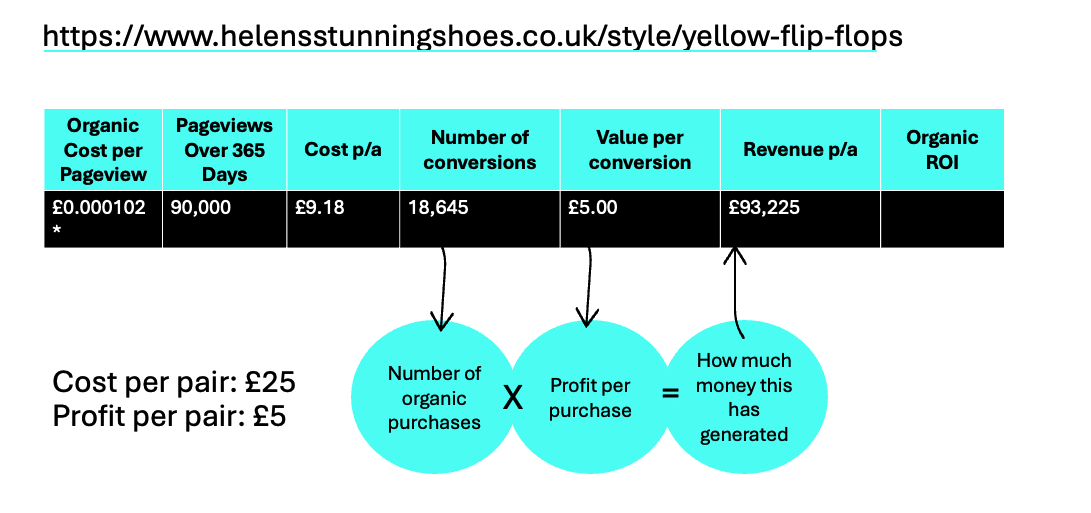
Using the above sample metrics for the yellow flip-flop pages:
- 18,645 conversions
- £5 per conversion (net value, after refunds etc.)
- Annual revenue = 18,645 × £5 = £93,225
Calculate ROI
Now plug the numbers into the formula:
(Annual organic pageviews × cost per pageview) – annual organic revenue
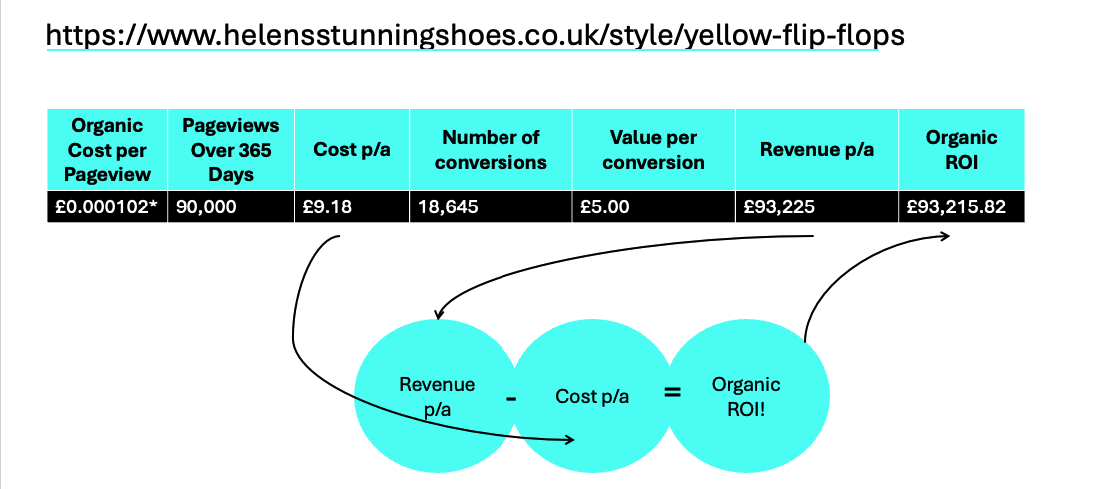
For the yellow flip-flops page:
- Cost per year: 90,000 × £0.000102 = £9.18
- Organic revenue: £93,225
- Organic ROI = £93,225 – £9.18 = £89,990.82
3. Calculate assisted value
Some content doesn’t drive direct revenue but still plays a critical role in conversions or visibility.
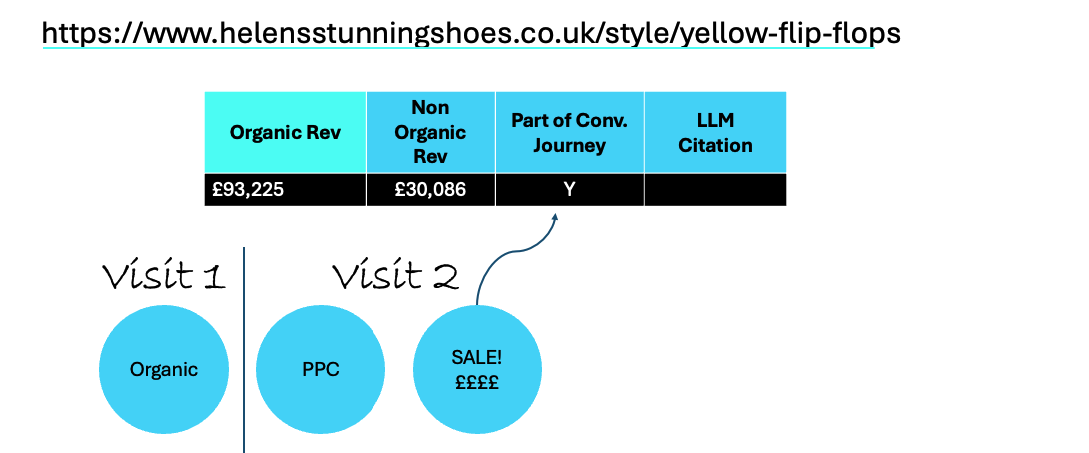
- Flag URLs that contribute to assisted conversions (via GA4 attribution or CRM data).
- Consider the role the content plays across other channels, like email or paid, or if it appears in AI overviews and LLMs.
- Assign binary values to indicate that a URL supports the wider strategy, even if it doesn’t convert on its own.
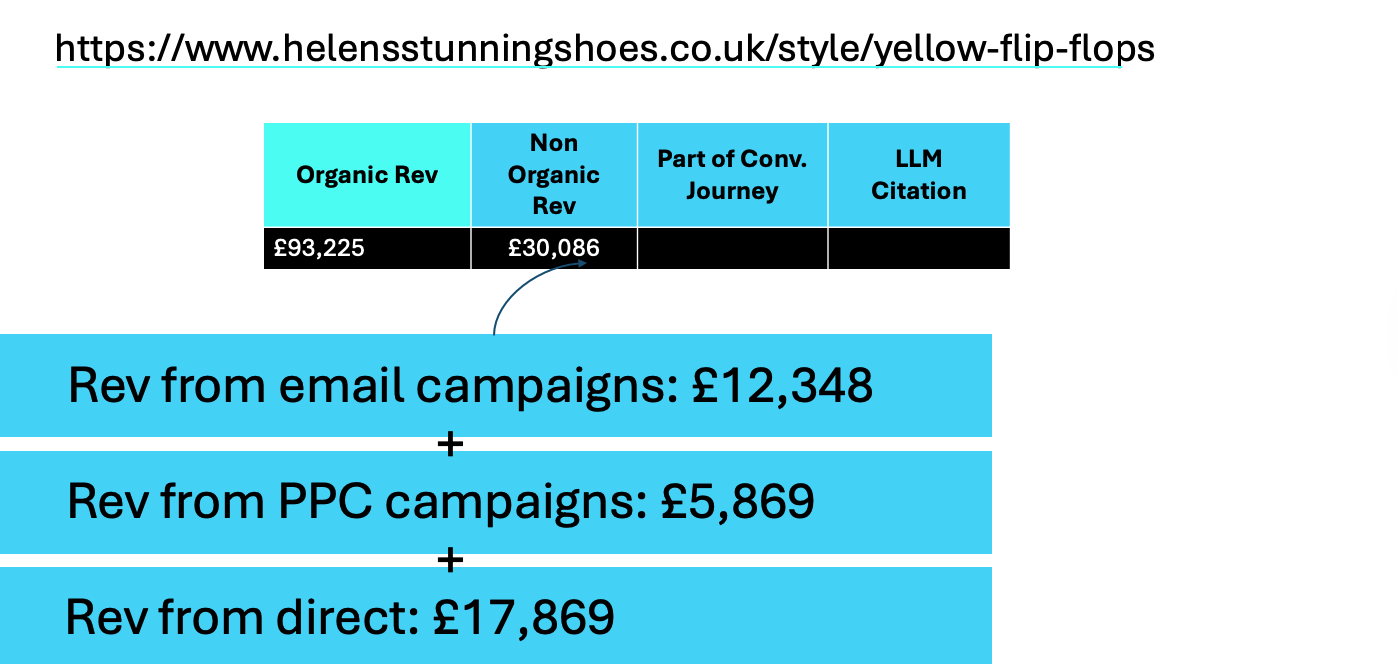
Using the flip-flop site again, a “best flip-flops” article might not convert directly, but it helps users discover the brand, drives email signups, and increases branded searches later. That’s strategic value worth factoring into ROI.
4. Classify pages by business impact
Group content by ROI and strategic contribution:
High-value pages are clear business drivers that generate revenue or assist-heavy content with positive ROI.
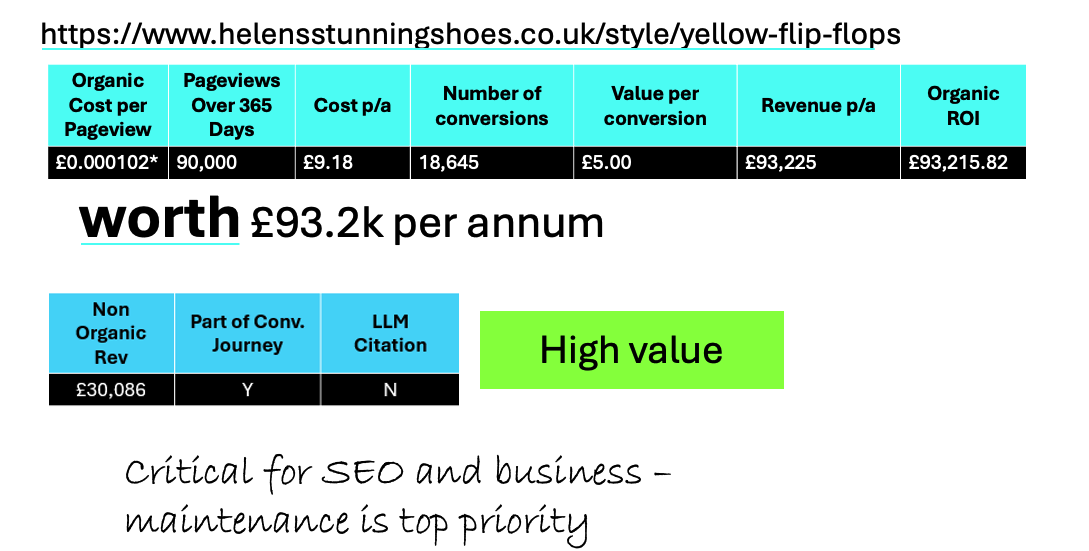
For example, the yellow flip-flops page brought in £93.2k in organic revenue and £30k in non-organic revenue over 12 months. It also played a role in multi-channel journeys, making it critical for SEO and business success.
Medium-value pages contribute indirectly. They might not generate much organic revenue, but support other teams or channels.
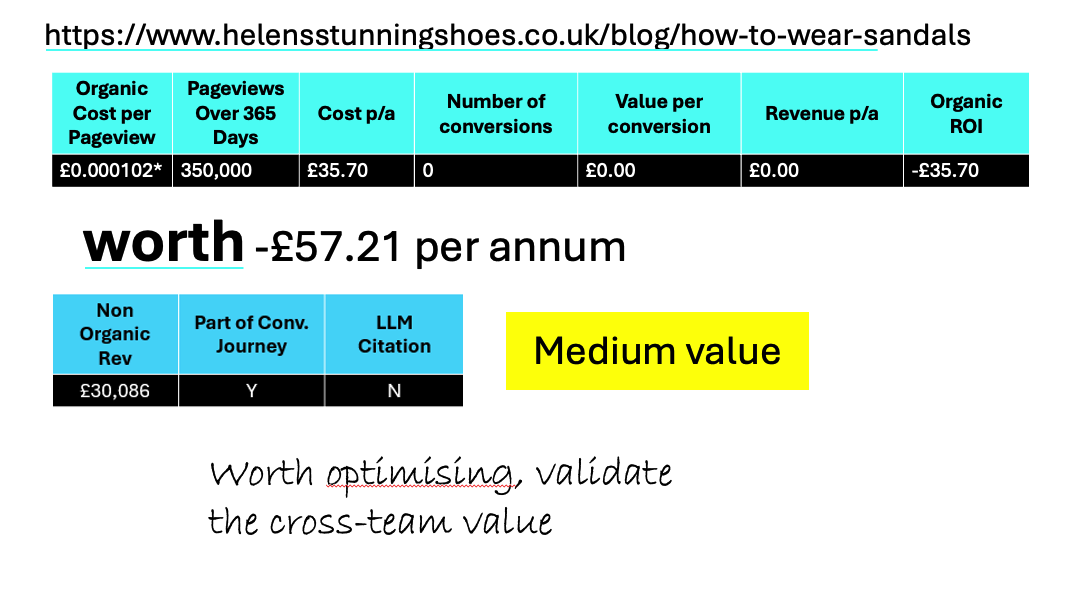
Take the “how to wear yellow sandals” blog post. It had zero direct revenue, but played a part in customer journeys that led to £30k in non-organic revenue. This kind of content is worth optimizing and validating across departments.
Low-value pages have minimal ROI, but still serve a purpose, whether it’s brand positioning or niche relevance. They don’t drive conversions, but might be worth keeping around if they support broader goals.
Net-negative pages cost more than they return. These are often high-traffic pages with no conversion that look impressive in analytics but quietly drain budget.
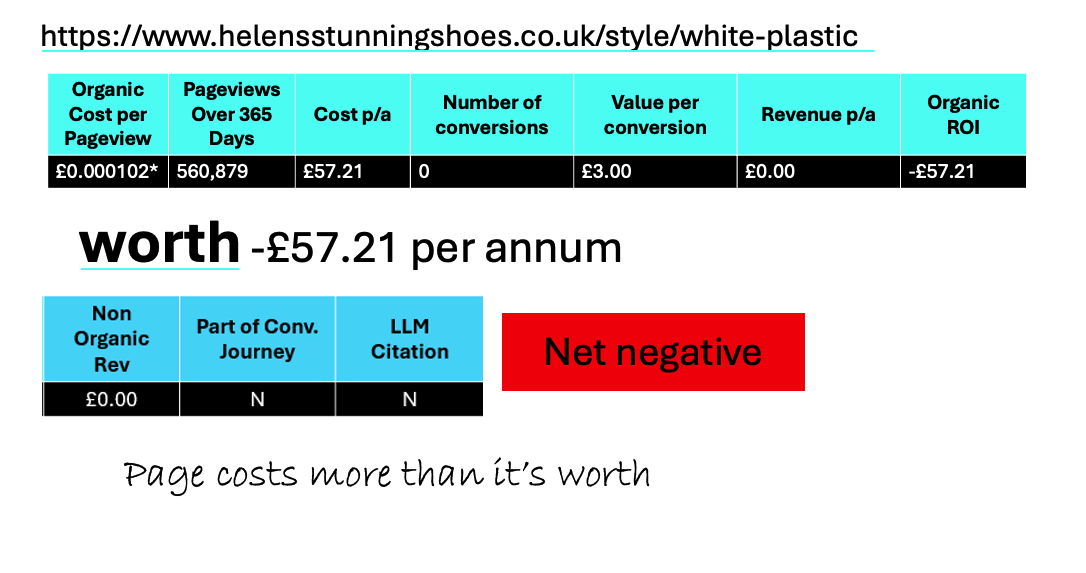
For example, the white plastic flip-flop page racked up over half a million pageviews but didn’t generate any revenue and cost the business £57.21 to host. With no conversions or cross-channel value, this page is losing money and should be removed or repurposed.
Get actionable insights to fix declining traffic and improve visibility
only at MozCon New York

Practical use case of the content value matrix
Once you know what’s working, use the content value matrix to prioritize updates, justify investment, and make budget-aligned decisions that stakeholders care about.
Get buy-in and justify budget
Use this framework to get stakeholder buy-in by attaching financial value to your SEO activities.
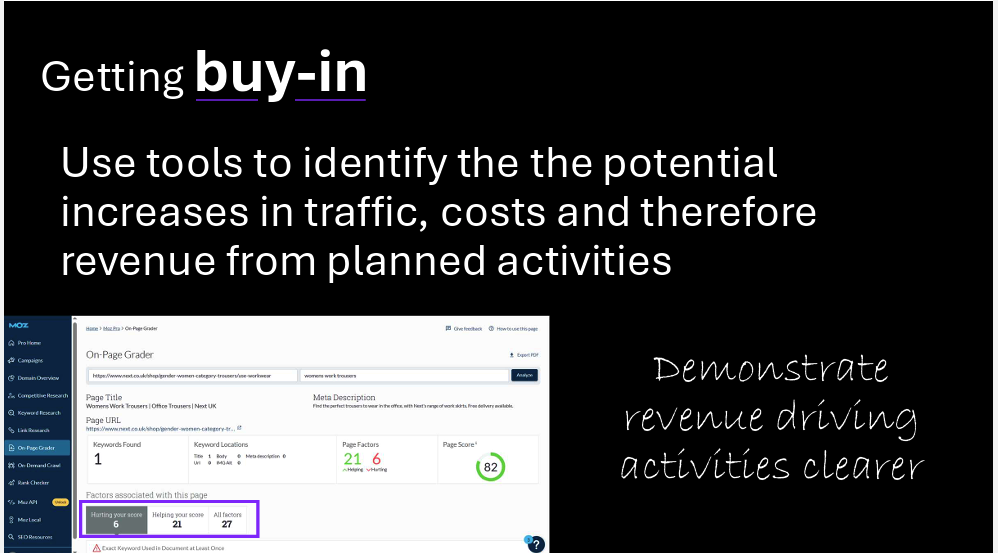
When you pair it with an SEO tool like Moz Pro, you can show how optimising a specific page could lead to increases in traffic, what that traffic would cost to serve, and how much revenue it’s likely to generate. This makes conversations with non-SEO stakeholders clearer and more persuasive.
Prioritize work
Once you've classified pages into high, medium, low, or net negative value, you can make smarter decisions about what to focus on.
Some pages might not drive revenue, but they consume resources. Removing or updating them could save money. Others might not be top performers today, but show clear potential with some investment.
Forecast value
Forecasting future value is notoriously difficult in SEO, but this model gives you a framework that brings clarity.
Using SEO tools like Moz Pro, you can estimate how much additional traffic a page might gain with better optimization. From there, it’s just a matter of plugging in the numbers.
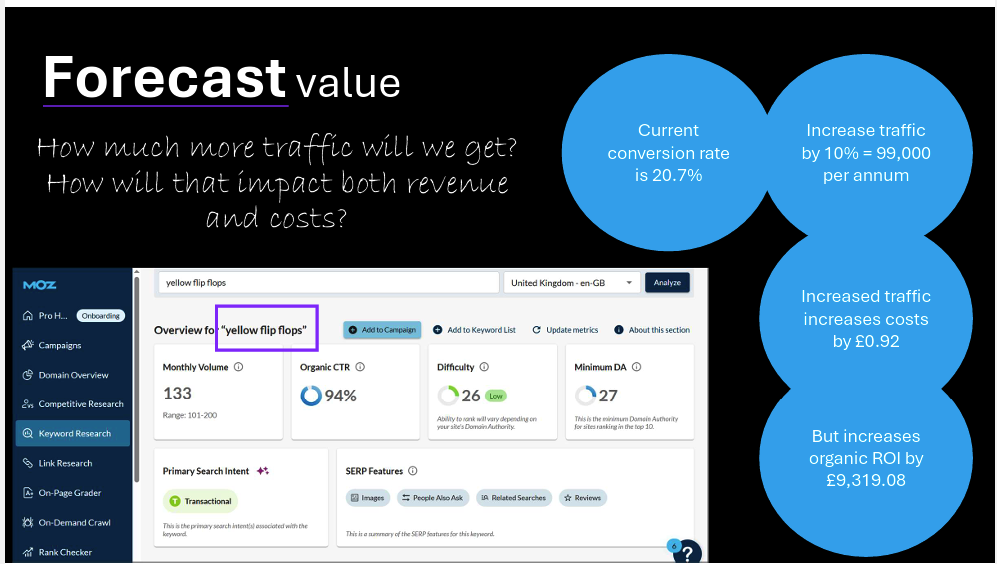
Let's take Helen’s Stunning Shoes as an example and assume the yellow flip-flop page has a conversion rate of 20.7%. If we grow traffic by 10%, that’s an additional 99,000 visits per year using our previous metrics.
Serving that extra traffic would increase costs by 92p, but based on the existing conversion rate and value per conversion, the forecasted boost would increase organic ROI by £9,319.08.
Identify high-performing pages
Use the content value matrix to spot patterns across high-performing content.
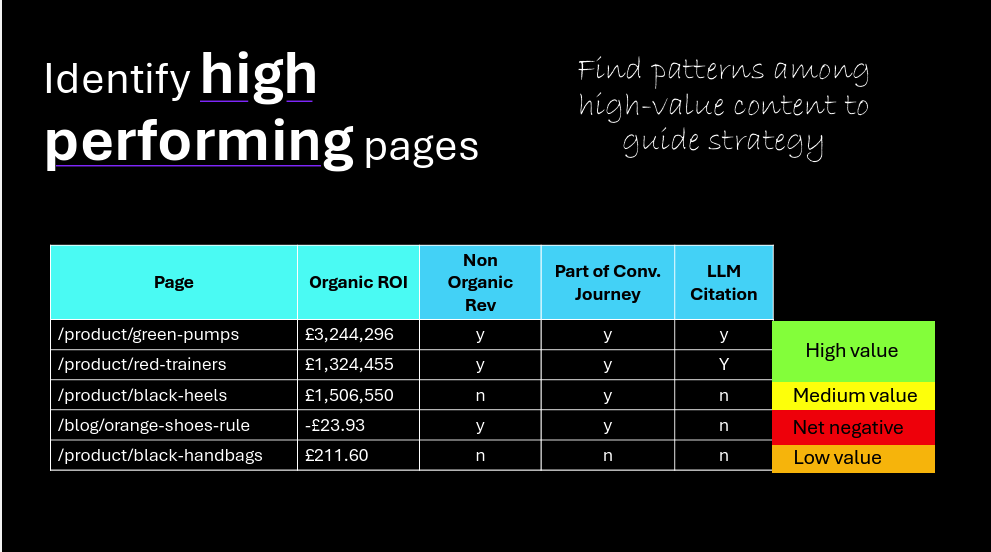
For example, you can see that most of the high-value pages tend to revolve around trainers or black shoes, which is a signal to double down. The same is true for low-performing content like orange shoes. It may be time to cut it if it's not generating value or supporting other channels.
Don't miss the SEO event of the year
Get actionable strategies to improve your SEO skills, only at MozCon New York

Concluding thoughts: Use the content value matrix to eliminate waste and maximize budget
This ROI model helps you move beyond traffic and focus on revenue drivers. By measuring real business impact, you can identify your money pages, eliminate content waste, and forecast growth.
The author's views are entirely their own (excluding the unlikely event of hypnosis) and may not always reflect the views of Moz.





